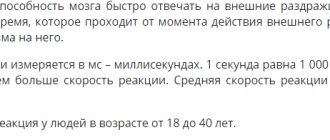How to learn to read faster
People who want to become professionals in their field must work through a huge amount of information. In addition, there are so many interesting books in the world, and I would like to read everything, but I am sorely short of time. There is a way out - learn to read quickly. And this is possible: Napoleon Bonaparte, Honore de Balzac, Albert Einstein, John Kennedy, Maxim Gorky and others read quickly, up to 2 thousand words per minute. For example, Napoleon read one rather voluminous book every morning before breakfast, managing to mark important things in its margins. thoughts for him.
And former American President Theodore Roosevelt, who reads at incredible speed, developed his own method of speed reading, which is now successfully used by those who want to learn it.
It could be argued that reading quickly reduces reading comprehension and retention. But practice shows that the opposite is true: with normal reading, approximately half of the information is absorbed, while with speed reading, 70-80%.
Why does this happen? Because fast reading requires more concentration than normal reading, during which we read less carefully. We have parallel thoughts: we think about current affairs, for example, that it’s time to turn off the refrigerator, about the upcoming vacation, or our thoughts return to past events. It is not surprising that reading progress is slow, and new information is poorly remembered.
You can master speed reading methods at special trainings: 5 lessons of 3.5-4 hours are enough. Their advantage lies not only in the fact that the classes are taught by specialists, but also in the fact that, firstly, the person who paid for the training is unlikely to want to voluntarily skip classes. Secondly, teachers form pairs of students, making classes more effective. Thus, the one who risks missing class will let his partner down - the obligation to him will serve as an additional incentive not to shy away from classes.
You can learn to speed read on your own. To do this, you just need a great desire, faith in the result and daily training. And if many people have the desire, then with faith it will be more difficult. Let's remember how children learn to ride a bicycle: those who think they will fall actually fall; those who are sure that they will go straight away somehow miraculously keep their balance and go. We believe that we can do it!
As for training, we do special exercises every day for 30-40 minutes for 21 days. Psychologists believe that it takes so long to get rid of an old habit and instill a new one.
For exercises, you need to choose a convenient time and place so that nothing distracts you from reading. It is useless to do this, for example, in the subway, where it is impossible to concentrate.
Development of peripheral vision
One of the main tools for speed reading is peripheral, or lateral vision.
It is carried out by the peripheral areas of the retina and allows, instead of several letters, to see and perceive a word or even a whole line. The classic way to train peripheral vision is to work with the Schulte table. Such a table is a field divided into 25 squares: five horizontally and five vertically. Each square contains a number, from 1 to 25 in total, in random order. The student’s task is to sequentially find all the numbers in ascending or descending order, while looking exclusively at the central square.
The Schulte table can be printed on paper, but today there are dynamic online generators and downloadable computer and mobile trainings, including those with a built-in timer. Those who use extensive speed reading training programs are advised to “warm up” with the Schulte table before training. If desired, you can switch from black and white 5x5 tables to more complex versions: for example, with colored fields.
What does speed reading give a person?
The benefits of speed reading will be especially appreciated by people dealing with large volumes of text. Lawyers, philologists, historians, teachers, scientists. Speed reading allows them to seriously increase the efficiency of their activities.
Speed reading skills will be very useful during your studies. Pupils and students will be able to spend less time memorizing material, understand it better and eliminate pointless cramming.
As you can see, the method has a lot of advantages. The only negative is the difficult and slow process of mastering it. You will have to show persistence and self-discipline to start learning speed reading and not give up halfway. But this is a feature of all effective methods of self-development. Do you want to get results? Please work hard!
Suppression of subvocalization
Another of the cornerstone principles of learning speed reading is the rejection of subvocalization: pronouncing words in the head and micro-movements of the tongue and lips. A person is able to pronounce on average no more than 180 words per minute - and it is no coincidence that this is the maximum number for ordinary reading. However, as text comprehension speed increases, words become more difficult to pronounce, and subvocalization begins to interfere with the development of a new skill.
There are several simple exercises to suppress mental recitation. For example, while reading, you can press your tongue to the roof of your mouth, hold the tip of a pencil between your teeth, or even simply put your finger to your lips, as if telling yourself: “Quiet.” There are also techniques in which the pronunciation of words is “confused” by chaotic tapping, the sound of a metronome, or music.
Setting the reference
Before we learn to read faster, we need to know the current reading speed, which is the benchmark and average today.
According to philologist Anatoly Somov, the average reading speed of an adult is 300 words per minute.
- Third grade students = 150 words per minute
- Eighth graders = 250 words per minute
- College student = 450 wpm
- Adults with higher education who have mastered speed reading skills = 575 words/min
- Institute professors = 675 words per minute
- Average speed reading speed = 1500 words/min
- World champion in speed reading = 4700 words per minute
Debunking myths about reading speed
Myth #1: Reading more than 10,000 words per minute
In movies or on television, you may have seen brilliant people who quickly read some encyclopedia and, thanks to their perfect memory and speed reading skills, instantly memorized a huge amount of information in a short period of time.
But do not forget that cinema and television are, first and foremost, shows that are created for entertainment. In real life, it is unrealistic to read half an encyclopedia in a short period of time, not to mention remembering such a volume of information.
According to eye movement expert Katerina Raine, exceeding a reading speed of more than 500 words per minute is extremely unlikely due to the complexity of our brain's processing of visual information (given the mechanical process of our eye movements). So, she believes that our eyes focus on one line of text to make our brain more comfortable processing the visual information it receives. In this regard, according to the expert, reading more than 500 words per minute is extremely difficult.
However, speed reading experts say you can get around this barrier by reading and processing multiple lines at once.
But, according to neurologist Sergei Kim, this is impossible for two reasons:
A. The fovea, or the central recess of the retina (lat. fovea centralis) is the area of our eye in which visual details are processed. This pit is only about 0.2 to 0.4 mm in diameter. This means that our reading speed is physically limited in terms of our ability to fixate on visual information, which is quite small.
B. Humans face working memory limitations in our brains. Thus, we can only retain “3-5 pieces” of information at a time when reading. The perception and short-term memorization of several lines at the same time is limited by our working memory, which we possess.
Myth #2: Subvocalization
Subvocalization is the inner voice in your head that says words when you read. That is, this is the mental pronunciation of words that you read to yourself.
Speed reading experts say that eliminating subvocalization is essential to improving reading speed.
According to Sergey Kim, although reading without using your inner voice can actually speed up your reading speed, you will almost always be forced to sacrifice something more important - understanding.
Subvocalization is necessary to understand what we read, and even the fastest readers subvocalize. The difference is that they just do it faster than the average reader.
By the way, the American space agency NASA has come up with a technology that makes it possible to capture impulses in the human brain that are formed in an astronaut during subvocalization.
Here's what Chuck Jorgensen, one of the NASA team leaders, said:
“Biological signals occur when reading or talking to oneself and actually lead to the movement of the lips or even the appearance of muscle movement on the face (facial expressions). And that is not all. A person using the subvocal system, thinking about the phrases he is reading, talks to himself so quietly that he cannot be heard, but his tongue and vocal cords do receive speech signals from the brain."
The same way you used subvocalization when trying to learn a new language. With subvocalization, you read a foreign language for understanding, not for speed.
To learn more about subvocalization, check out this article.
Myth #3: Reading = practice speed reading
We often mistake the fact of reading as training that can improve our reading speed.
But with normal reading, we don't actually develop the skill of speed reading, because practicing speed reading involves increasing our normal reading speed. And as you increase your reading speed, your reading comprehension will “go out the door” because in order to understand what you are reading, you need to return to your normal reading speed.
So you should know that it is ineffective to try to improve your reading speed by expecting comprehension from the information you read.
When you read, read for the sake of reading, at a normal (normal) speed. And, setting aside some time, do speed reading exercises to improve your reading speed.
Refusal of regressions
Regressions in speed reading are called returns to already read parts of the text. They occur when the reader is distracted by extraneous thoughts, or if the speed of assimilation of information is too high for the brain to be able to perceive all the information.
In particular, the Best Reader training program helps to cope with regressions. It is based on dynamically highlighting parts of text on a page in black. It is difficult for human eyes to make orderly movements without observing anything, and this feature allows you to better focus your gaze on the desired fragments. When reading a regular book or document on the screen of an electronic device, you can also use a simple trick that we all know from our preschool days: drag your finger across the page. It also helps to get rid of regressions by understanding that further text often makes it possible to fill in all the short information gaps that arose during the reading process.
Method 7. Determining paragraph topics
Each paragraph (if you read it carefully), or rather, all its phrases are united by a specific topic. If you learn to identify topics, you will greatly improve the quality of information you absorb.
How to train?
Just!
Take any book, read one of the paragraphs and try to quickly determine the topic. Next, take 5 minutes and determine the topics of the maximum number of paragraphs in this short period. The minimum number of identified topics per minute is 5.
And a couple more tips for the road:
- Reduce the length of time you pause on each line.
- Train skills individually. Don't try to cover all the techniques at once.
- Stop running your eyes along the line - take in the entire line at once.
Concentration of attention
Reading quickly requires high concentration. To develop it and not read texts superficially, there are several exercises. For example, you can use a sheet on which the names of the colors will be printed in colored font, but in such a way as to confuse the reader. The word “yellow” will be written in red letters, the word “red” in blue, etc. To practice, you need to name the color of the ink, and not the word that is written on the sheet, and at first it is quite difficult to do this.
For another exercise, you only need a blank sheet of paper and a pen. You need to focus your attention on some subject and not be distracted from it by extraneous thoughts for two or three minutes. Every time extraneous thoughts arise, you need to make a note on the sheet. Over time, there should be fewer such marks, and then they will disappear altogether.
You can also train your concentration while reading: just count the words in the text. It is important to carry out calculations exclusively in your head, without helping yourself with your fingers, tapping your feet, etc. After two or three minutes you need to stop and check yourself by counting the words without reading them. At first, the first result will differ from the second, but with regular training, the differences between them will quickly become minimal.
Method 6. Learning to recognize “key” words and discard unnecessary ones
When looking at a painting, you don’t ask yourself what the artist was trying to say. You just look and understand everything. Moreover, your gaze covers the whole picture at once, and not individual details.
A similar “scheme” is used here. You must learn to snatch signal, keywords from a line and cut off all unnecessary ones. Every word that does not carry a special meaning, used “for beauty” or a bunch of phrases in the text, is cut off, skipped, ignored.
The main focus is on keywords that carry the main information load.
Reading whole words
The Spritz app also aims to develop peripheral vision. For training, only one line is used here, on which words with a red highlighted letter in the middle appear at different speeds. In this way, you can learn to perceive words without reading them from beginning to end, but all at once. This allows you to save up to 80% of the time that would normally be spent on eye movements and increase your reading speed to 500–1000 words per minute.
On the official website of the application there is a demo version of Spritz, including in Russian. You can choose a speed from 250 to 600 words per minute and other languages: English, German, Spanish and French. In the future, the developers plan to create not only a version for websites and smartphones, but also an option for use within the interface of electronic glasses, smart watches and other compact devices, because the application requires only one line to work.
How to build communications within a team and manage it remotely? What unspoken rules of digital etiquette should you follow? Why is work-life balance disrupted and how to restore it? In the FreeBusiness project you will find all the necessary materials about effective management at a distance, tips on organizing remote work for managers and other employees.
Improper breathing
Often in my practice I have encountered the problem of improper breathing in children while reading. Some children literally suffocate while reading, and if they are not allowed to pause after every two or three lines read, their breathing can be compared to the breathing of a runner after a marathon.
Improper breathing can also manifest itself as problems such as:
- Monotonous reading;
- Very quiet or excessively loud reading;
- Long pauses between words and phrases;
- Unclear pronunciation of sounds and syllables.
This, of course, is a serious problem that can be eliminated with special exercises. Children really like these exercises, which has a positive effect on their emotional attitude to the reading process.
Exercise 1
Inflating a watermelon
A fun exercise that kids really enjoy. It is necessary to inhale as much air as possible so that it fills the lower abdomen. At the same time, the tummy inflates and becomes like a watermelon. The exhalation should be as long as possible.
Exercise 2
Boiling water
We pour water into a cup or glass, and the child exhales air through a cocktail straw, creating fun bubbling bubbles.
Exercise 3
Ball, roll!
We take a light ball, suitable for small tennis or badminton. The child blows on it so that the ball rolls forward and as far as possible.
This exercise can also be performed with two balls lying next to each other at once. In this case, both balls should roll at once.
Exercise 4
Egorki
To perform the exercise, you need to inhale as much air as possible, and then say: “There are 33 Egorkas on the hill” and on a very long exhalation, try to count as many Egorkas as possible, that is, say without interruption: “One - Egorka, two - Egorka, three - Egorka "...
Exercise 5
We walk and count
This exercise is good to do while walking or at home. You need to take steps and count to yourself at the same time. The first 3 steps inhale and count 1-2-3, the next 3 steps exhale and count 1-2-3.
Then inhalation and exhalation can be increased to 4-5 steps.
A more complicated version of the exercise is when the exhalation is longer than the inhalation. For example, inhale 4 steps and exhale 6 steps.
Working with syllable tables
To increase reading speed, it is important to train the child to perceive a syllable as a whole, as the basis for reading a word. For such exercises, special tables of syllables are required. You can use didactic material to teach reading according to N. Zaitsev’s method or create such tables yourself.
Children are offered various tasks:
- read a line or column with a specific letter;
- arbitrary reading of syllables;
- find the indicated syllable in the table;
- Show the word in the table syllable by syllable.
First, tables with simple syllables are used, and then move on to more complex ones, consisting of three to four letters.
Where can I get texts for verification?
Selecting a text to check is a responsible matter. These texts have special requirements. I wrote about them in this article. Where can I get them?
Option one. You can contact your son or daughter's teacher. Explain the situation to her. She will, of course, be very happy and will immediately give you some kind of teaching aid with texts to test your reading technique so that you can make a copy of it.
Well, if the teacher doesn’t help, then there is always a second option. Go to the bookstore and buy yourself your manual. There are such books.











